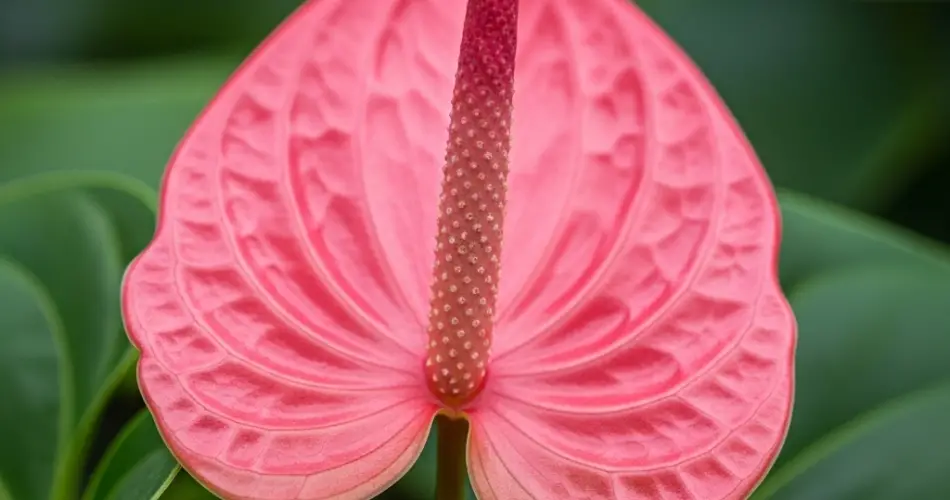Anthurium, often called the “flamingo flower” or “laceleaf,” is prized for its striking, heart-shaped blooms and glossy foliage. Native to tropical regions of Central and South America, this exotic plant has found its place in homes around the world as a popular houseplant. With proper care, anthurium can produce vibrant blooms continuously throughout the year.
Here’s how to cultivate a healthy, blooming anthurium that brings beauty to your space all year long.
1. Provide the Right Lighting Conditions
Light plays a crucial role in the flowering cycle of anthuriums. These tropical plants prefer bright, indirect light. Too much direct sunlight can scorch their leaves and flowers, while insufficient light may hinder blooming altogether.
The best location is near an east- or north-facing window, where they receive gentle morning or diffused light. If natural light is limited, consider using a grow light to provide the necessary brightness without overheating the plant.
2. Choose an Ideal Potting Mix
Anthuriums thrive in loose, well-aerated soil that mimics the organic, moisture-retentive environment of their native rainforests. A potting mix composed of orchid bark, perlite, and peat moss (or coconut coir) allows for optimal drainage and airflow to the roots.
You can also purchase a premixed orchid or aroid soil blend, which typically contains the right combination of ingredients for anthurium. Avoid compact soils that retain too much water, as these can lead to root rot.
3. Water Correctly
Anthuriums require consistent moisture, but they don’t like soggy soil. Let the top inch of the potting mix dry out before watering again. Overwatering can suffocate the roots, while underwatering may stress the plant and reduce flowering.
Use room-temperature water, and ensure that your pot has drainage holes. After watering, allow excess water to drain fully. During the cooler months, reduce watering frequency to match the plant’s slower growth cycle.
4. Maintain Warmth and Humidity
Being tropical, anthuriums love warm temperatures and high humidity. Keep the plant in a room where the temperature stays between 65°F and 80°F (18°C–27°C). Avoid cold drafts, sudden temperature drops, and proximity to heaters or air conditioners.
To maintain humidity:
-
Mist the plant regularly.
-
Place a humidifier nearby.
-
Set the pot on a tray with water and pebbles to increase ambient moisture.
This is especially important in dry indoor climates or during winter when heaters are in use.
5. Fertilize for Flowering
To support year-round blooming, feed your anthurium regularly with a balanced, water-soluble fertilizer. Look for a formulation like 10-30-20, where the middle number (phosphorus) promotes flowering.
Apply fertilizer every 6 to 8 weeks during the growing season (spring through early fall), diluted to half strength. Over-fertilizing can burn the roots and cause leaf damage, so err on the side of caution.
6. Prune and Clean the Plant
Regular maintenance keeps your anthurium healthy and blooming. Remove faded flowers and any yellow or damaged leaves using clean, sharp scissors. This helps the plant redirect energy into producing new blooms.
Also, wipe the leaves with a damp cloth to remove dust. Clean leaves not only look better but also allow the plant to photosynthesize efficiently, which supports overall health and flowering.
7. Repot Every 1–2 Years
As anthuriums grow, their roots may outgrow the pot. Repotting every 1–2 years rejuvenates the plant and gives it space to flourish. Signs your anthurium needs repotting include roots poking out of the drainage holes or slowed growth.
Choose a pot that’s 1–2 inches wider than the current one and refresh the potting mix. The best time to repot is in spring or early summer, when the plant enters its active growing phase.
8. Troubleshoot Blooming Issues
If your anthurium is healthy but not blooming, review its care conditions:
-
Is the lighting sufficient? Insufficient light is the most common reason for a lack of flowers.
-
Is the humidity adequate? Dry air can delay blooming.
-
Has it been fertilized? Lack of nutrients can stall flower production.
Sometimes, just moving the plant to a brighter spot or resuming a proper fertilizing schedule is enough to trigger blooming.
9. Keep an Eye on Pests
Anthuriums are relatively resistant to pests, but indoor conditions can attract aphids, spider mites, or mealybugs. Check the undersides of leaves and leaf joints regularly. If you spot pests, remove them with a soft cloth and treat the plant with neem oil or insecticidal soap.
Early intervention prevents infestations from damaging your plant or hindering its ability to bloom.
Final Thoughts
With the right care, anthuriums can bloom beautifully throughout the year, making them a rewarding houseplant for both beginners and experienced plant lovers. By providing the ideal balance of light, warmth, moisture, and nutrients, you can enjoy the striking colors and bold leaves of this tropical treasure in any indoor space.



